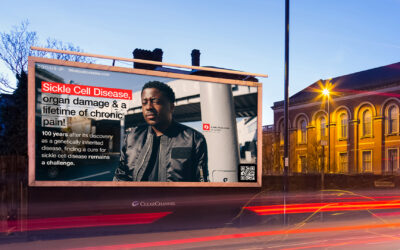This is What Sickle Cell Disease Looks Like: The Lived, Day-to-Day Perspective.
Lea Kilenga Masimo Bey, leader of the Africa Sickle Cell Organisation, speaks on the importance of listening to individual and SCD community experiences to improve care for patients worldwide.
For Lea Kilenga Masimo Bey, what empowers her Sickle Cell Disease (SCD) advocacy work is the same thing that has, at many points in her life, caused her unimaginable pain. Her body.
Lea’s motivation in bettering outcomes for patients in Sub-Saharan Africa and beyond was built on lessons that her body has taught her. Through her experience with SCD, she has learnt measure and balance, the importance of pushing through hardship, and compassion towards all Sickle Cell voices. Listening to her body’s needs, as well as the needs of individuals and wider communities, are keystones in directing her organisation’s activity to support SCD patients across Africa:
“As a person living with Sickle Cell, I understand my body and my health are my greatest asset for this work. This work has me seeking to do and be better each day. Better as a leader and better as a person with SCD. Better means learning, skilling and improving myself to be better at running a non-profit addressing SCD and positioning us better to attract partners and resources to allow us to help more patients.”
“As iron sharpens iron, so does SCD sharpens me in all ways at all times. However long I have to do this work, I will do so to be better each day.”
At its core, Lea’s work focuses on applying the lessons she and others have learned towards creating an SCD pain-free Africa. In her eyes, living pain-free for patients in her community not only refers to being relieved of SCD symptoms and crises; but also enjoying frictionless access to education, resources and knowledge on the condition:
“As a community, we are stronger in numbers working towards the same goal, a sickle cell pain-free Africa. With patients working together, it’s easier to skill, provide resources and information that can inform policy and systems in places closest to them.”
“When local and regional policy is in place, hospitals and doctors are equipped, patients and families empowered; we can begin to address more specialised care like end organ damage beyond our most immediate needs.”
“This may also include allocating funding to address social determinants of sickle cell to help patients and families thrive.”
The ability to thrive while having SCD is a goal that is important to Lea. To help many achieve this, she draws inspiration from other SCD patients, especially concerning their lived physical and emotional experiences. Their stories, those of communities and the individual person, motivate Lea’s work to assist patients on a national and practical level.
Her organisation is one of the first in the world to address SCD inequalities by providing insurance access and care for patients in Sub-Saharan Africa. Whereas many have focused solely on promoting awareness, the Africa Sickle Cell Organisation raises the bar in delivering needed practical, medical and overall support for patients in the region. It highlights untapped avenues for individuals, families and entire communities to manage the practical details of living with SCD daily; as well as supporting them through policy change and advocacy.
“Africa Sickle Cell Organization (ASCO) identifies and provides resources and support towards SCD-focused community-based organisations to reach every patient and change systems that directly affect them.”
“The most direct way I hope to do this is through an education platform for advocacy that will share knowledge and provide resources for programming across Africa. I realise communities are at the centre of accountability and sustained systems change.”
Lea has chosen to support patients in this way because many advocacy bodies often miss the “context” and finer details of living with SCD in Sub-Saharan Africa. As she states, the reality of having SCD is far more complex than what many account for. Even by listening closely to individual and community stories, we will only ever be able to scrape the barrel of what it means to have SCD:
“They miss context. There is a misapprehension that sickle cell will be solved by doctors and researchers alone. Well, this might be true to an extent but based on the past century since discovery, but little has changed with regards to the quality of life of patients – especially those living in Sub-Saharan Africa.”
Lea’s reasoning for this focus is the fact that care is still unaffordable for many for multiple reasons. To promote the longevity of better care, resources and advocacy on behalf of Sub-Saharan SCD communities, she prioritises sustainable and practical strategies to support them. Depending on the everyday details of a patient’s life, for example, where they live or how far they must travel to access care, she and her organisation curate support methodologies bespoke to every community:
“SCD care is still centralised in urban areas of Africa. This means that if you have sickle cell and come from a rural area, you have to travel long distances and spend money you don’t have in search of care. This is not sustainable. Furthermore, care is still not affordable to all. Patients and their families largely spend large out-of-pocket costs to pay for medicines and inpatient and outpatient care. In addition, early diagnosis is not universal.”
In her view, many charitable organisations are not alone in misinterpreting the reality of living with SCD in her community. She also states that national bodies, global corporations and health systems’ work often does not align with the priorities that individuals and communities might have. In tandem with the lack of pace and action, she notes that the burden to improve the SCD experience falls on patients’ shoulders.
To reverse this, Lea recommends engaging more with the SCD patient voice, as well as the contextual needs of communities:
“With people living with sickle cell bearing the disproportionate burden of inaction, it seems wise for African governments to encourage and foster their meaningful involvement. When policies, programmes, and services are co-designed with communities, they are more likely to be relevant, appropriate, scalable and sustainable.”
“By ensuring that they are focused on people, not diseases, they can effectively respond to the needs and realities of those they are meant to serve and leave no one behind.”
To raise awareness of SCD, we are working with advocacy leaders like Lea Kilenga Masimo Bey and other members of the SCD community to make improved SCD care a reality.
Learn more about raising awareness around Sickle Cell Disease by accessing Sanius Health’s campaign site: https://whatscdlookslike.com/




